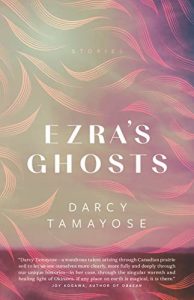After the terror attacks on New York City and Washington D.C., we saw novels influenced by that tragedy. Darcy Tamayose’s latest book may not be arriving with the same fanfare as the 9/11-influenced works by DeLillo, Messud or Auster, but like those authors she successfully captures the intimate, felt experience of a world-changing event. While only two of the four stories in Ezra’s Ghosts mention COVID-19, the collection’s themes of grief, uncertainty, memory and hope will be recognizable to anyone grappling with pandemic life.
The ghosts of Ezra (a fictionalized version of Lethbridge) are both metaphorical and literal. The reader learns on the third page of “Ghostfly” that Dhia, the narrator, is speaking from beyond the grave. Her murderer is revealed early; this is not a supernatural thriller à la The Lovely Bones. As a ghost, Dhia is “privy to a deeper layer of those [she had] left behind.” An omniscient narrator is a tricky perspective to employ; thankfully the author is up to the challenge. Beautiful descriptions of the “whole repertoire of winds” in Ezra are met with simple depictions of the small ways the grief-stricken hide themselves from the world without a loved one.
The two shortest stories are linked, forming bookends for the collection. In the first, told mostly through email, a young Ph.D. student leaves his pregnant lover behind in Ezra while he takes a short research trip to China in January of 2020. The correspondence is one-sided, and at the story’s conclusion we come to understand the reason for his lover’s silence. The final story picks up their relationship decades later, in 2044, a world of holographic AI immortality and bioterrorism, where scholars still joust over disciplinary boundaries and methodological practices.
At times it feels as if the author’s own academic pursuits (Tamayose is a Ph.D. student at the University of Lethbridge) shine a bit too clearly through her creations. A tenured literature professor and a 130-year-old Ryukyuan immigrant living on the prairies both read the same critical theorists. The line “she thrived on the diverse dialectic rigour of forward-thinking global voices outside of the Western theoretical sphere” signals campus-speak satire but asks to be taken seriously.
Yet these complaints are minor and the incidents rare. More frustrating is Tamayose’s need for neat endings. The subtle, mysterious power of the novella-length “The Ryukyuan” is threatened by a hastily tied-up ending, complete with an emotional twist. It is a testament to Tamayose’s work with character, image and tone that the rushed denouement does not mar the uncanny and heartfelt tale, the strongest in the book.
Yutaka Dirks is an Alberta writer now living in Winnipeg.


